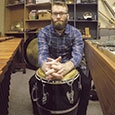Even seasoned percussionists sometimes produce undesirable sounds on their instruments because a lack of focus and concentration leads to playing an instrument in the wrong spot. Throughout my experiences teaching young percussionists and music educators, I have found that one of the fundamental aspects of percussion technique to be overlooked in both rehearsal and performance is proper playing area. Knowing where to strike each instrument can drastically improve the sound of the percussion section and of the ensemble as a whole.
Snare Drum
The tendency for young students playing the snare drum is to hit right in the center of the drumhead. However, for medium to loud dynamics, the ideal playing area is actually slightly outside of the center.

The sound becomes more resonant here because it is a tighter area of the drumhead. As dynamics diminish, it is common practice to shift farther towards the edge of the head, moving in a straight line out from the body. The drum should also be set up so that the snares on the underside of the drum follow this same straight line.
This ensures that the student is always playing above the snares and therefore producing the most precise and crisp tone possible. Playing a passage first above the snares, then outside of the snares will demonstrate this change in tone.

Tambourine
The playing area of the tambourine is similar to that of the snare drum. Students can follow the same guidelines shown in the first snare drum photograph, playing slightly off-center for medium to loud dynamics and closer to the edge for softer dynamics. The straight line to follow moves outward from the point where the student holds the tambourine.

An easy way to improve soft tambourine tones quickly is to ensure the student is playing right above one of the jingles and still producing both the jingle sound and the sound of the tambourine head. A balanced and even combination of these two sounds should always be a goal when playing the tambourine.
Bass Drum
The bass drum is also similar to the snare drum and tambourine in some ways. Playing slightly off-center gives the desired tone, even in the softer dynamic range. The bass drum is large enough that this off-center area can cover the full range of dynamics needed.
On the marching field, bass drummers will usually play all medium to loud dynamics right in the center of the head and move outwards as they get softer. This produces a more defined attack that projects better in the outdoor stadium setting. Playing in the center of the head is sometimes appropriate in concert band as well, but this technique is generally reserved for more rhythmic passages or when a punchier sound is desired, such as when playing a march.
Timpani
Timpani display the greatest transformation in sound when shifting from an improper to a proper playing area. The performer should play roughly one third of the distance from the edge of the drum to the center.

Similar to the concert bass drum, it is easy to produce a great tone throughout the majority of dynamic ranges in this single playing area. Students should be careful not to move too close to the edge of the drum, as the sound becomes quite thin and no longer produces a full, rich sound, which is fundamental to the role of the timpani.
Suspended Cymbal
The suspended cymbal can produce beautiful swells of sound when played properly. For single strokes on the cymbal, the proper playing area is roughly the outside one-third of the cymbal.

If a student plays the cymbal too close to the bell or center, the tone becomes more pointed and loses the vibration that characterizes the suspended cymbal sound. Playing on the bell is acceptable when called for by the composer but should be avoided otherwise. When playing rolls on the suspended cymbal, the goal is to get the entire cymbal vibrating as soon as possible, as this will produce the most full-bodied and lush tone. This is accomplished by positioning the mallets at opposite edges of the cymbal. This way the sound will be as full as possible regardless of the dynamic when the roll begins.
Triangle
The sound of a triangle can also change significantly from improper to proper playing areas. For single strokes, the student should strike the triangle in the center of the bottom side. The quality of tone changes depending on the angle at which the beater strikes the bottom side. For a thinner, simpler, more pointed sound, strike the bottom straight on.

For a sound that is darker, and containing more overtones, the student should strike the bottom at a 45-degree angle.

This angle causes the ends of the triangle to vibrate opposite of each other, producing more overtones and a lusher sound. When playing rolls on the triangle, move to the right corner of the bottom side, and alternate strokes between the bottom and top of the enclosed corner. The roll sound can also be changed by adjusting the angle of the beater and will produce varying tones according to the angles described earlier.
Mallet Percussion
When playing mallet percussion instruments, students should avoid the area where the yarn runs through the bar, also known as the node. Because the bar is hollowed out at these points to allow yarn or chord to be threaded through and hold the bar in place, the sound is much less resonant than when played elsewhere. Students should become accustomed to playing either on the edge of the bars, or right in the center.

It is common practice to play on the edge of bars when playing accidentals in the upper manual, and to play right in the center of the bar when playing in the lower manual. This makes it slightly easier, especially for younger students, as they don’t have to reach quite as far to play the upper manual. This change in tone is quite obvious, and will immediately improve the overall sound of a student’s mallet playing.
Conclusion
Simple changes in technique can instantly produce higher quality sounds. Once a percussionist or director becomes accustomed to more desirable tones on these instruments, the use of improper playing areas should immediately be distinguishable. However, without this awareness, these fundamental flaws often go unnoticed. These techniques apply to all realms of percussion playing – from the marching band field, to the concert hall, to the drum throne of a jazz ensemble. All it takes is an ongoing attention to detail to produce ideal results.






